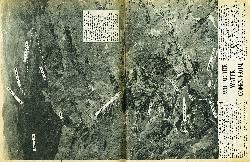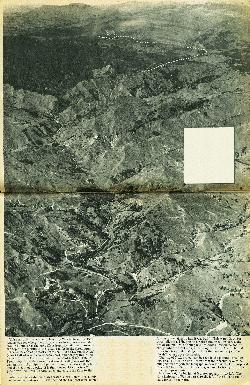8
Where The Water Comes From
This aerial picture, specially taken by "Photo News" so that readers can see where their water comes from, covers the vital five or six miles ( as the crow flies) from the catchment areas at the top of the picture to the settling tanks in the foreground.
The water comes primarily from the "Bush Catchment Area (about half of which can be seen here), and congregates in the valley of the Te Arai stream above the point marked "Intake". From there it travels four miles down the valley towards the camera in an 18in pipe, and passes through the two settling tanks and the treatment works. It is then carried 18 miles in a 21 in pipe down the lower Te Arai valley and across the flats to the city.
When the bush catchment area water is insufficient, the supply can be augmented from the lake behind the Clapcott dam (named for the city engineer when it was built). This water flows for three miles in a 17in pipe in a right-hand direction across the top of the picture, doubling back to cross a low divide and discharge into Smith's Creek, a tributary of the Te Aral There it flows free for a mile, falling 700ft in the process, to join the "bush" water above the intake.
The site of No.2 project can be seen in the picture. The Puninga area is off to the left. Water from there would have to be pumped over to join the Mangapoike development. It is proposed to use the fall in Smith's Creek to generate electricity for this and other pumps required.
Moumoukai, the big hill at Morere, appears at top left. The state highway to Wairoa passes to the left of the hill and the Nuhaka River to the right.
When Puninga (which lies out of The picture to the left above the bush area) is brought in, Gisborne will have the distinction of drawing its water from three major river sources, all shown in the upper part of this photograph. Puninga water flows into the Nuhaka River, the valley of which lies this side of Moumou- kai Hill Mangapoike water flows into the Wairoa River, and Te Arai water into the wai- paoa River. Even now a Manga- poike cusec supposed to flow through Wairoa can find itself coming out a tap in Gisborne.
9




